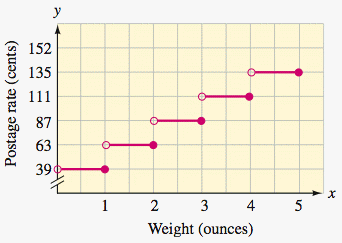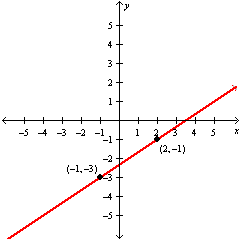A) f (0) = 10, f (-4) = -3, f (5) = 20, f (-9) = -13
B) f (0) = 7, f (-4) = -1, f (5) = 17, f (-9) = -11
C) f (0) = 6, f (-4) = -0, f (5) = 16, f (-9) = -10
D) f (0) = 8, f (-4) = -2, f (5) = 18, f (-9) = -12
E) f (0) = -7, f (-4) = 1, f (5) = - 17, f (-9) = 11
Correct Answer

verified
Correct Answer
verified
Multiple Choice
For a fixed rate and principal, the interest earned in a bank account paying simple interest varies directly with the length of time the principal is left on deposit. If an investment of $7,000 earns $700 in 2 years, how much will it earn in 8 years?
A) $2,700
B) $2,850
C) $2,750
D) $2,900
E) $2,800
Correct Answer

verified
Correct Answer
verified
Multiple Choice
The equation  can be used to convert from degrees in Celsius to degrees in Fahrenheit. Identify the graph of the equation.
can be used to convert from degrees in Celsius to degrees in Fahrenheit. Identify the graph of the equation.
A) ![]()
B) ![]()
C) ![]()
D) ![]()
E) ![]()
Correct Answer

verified
Correct Answer
verified
Multiple Choice
Find the equation of the line that contains the given point and has the given slope. 
A) ![]()
B) ![]()
C) ![]()
D) ![]()
E) ![]()
Correct Answer

verified
Correct Answer
verified
Multiple Choice
Graph the linear equation. 
A) ![]()
B) ![]()
C) ![]()
D) ![]()
E) ![]()
Correct Answer

verified
Correct Answer
verified
Multiple Choice
If the ratio of rise to run is to be  for some stairs and the measure of the run is 29 centimeters, find the measure of the rise to the nearest centimeter.
for some stairs and the measure of the run is 29 centimeters, find the measure of the rise to the nearest centimeter.
A) 160 cm
B) 4 cm
C) 5 cm
D) 15 cm
E) 20 cm
Correct Answer

verified
Correct Answer
verified
Multiple Choice
Tell whether the equation determines y to be a function of x . 
A) no
B) yes
Correct Answer

verified
Correct Answer
verified
Multiple Choice
Tell whether the lines with the given slopes are parallel, perpendicular, or neither. 
A) perpendicular
B) parallel
C) neither
Correct Answer

verified
Correct Answer
verified
Multiple Choice
Graph the equation. 
A) ![]()
B) ![]()
C) ![]()
D) ![]()
E) ![]()
Correct Answer

verified
Correct Answer
verified
Multiple Choice
Find the equation of the line that contains the given point and has the given slope. 
A) x = 8
B) y = 8
C) x = -4
D) y = -4
E) y = -8
Correct Answer

verified
Correct Answer
verified
Short Answer
Find the equation of the line that contains the given point and has the given slope. Express equation in the form  , where A , B , and C are integers.
, where A , B , and C are integers. 
Correct Answer

verified
Correct Answer
verified
Multiple Choice
The graph shown gives the first-class postage rates in the year 1999 for mailing items weighing up to 5 ounces. According to the graph, which of the statements is incorrect? Weight (oz) and Postage Rate (cents) 
A) The postage cost for mailing a 2-ounce letter is 55 cents ![]() .
.
B) The heaviest letter that could be mailed for 80 cents first class weighs 2 ounces.
C) The postage cost for mailing a 1-ounce letter is 33 cents.
D) The difference in postage for a 3.16-ounce letter and a 4.37-ounce letter is 20 cents ![]() .
.
E) The postage cost for mailing a 4-ounce letter is $1.00.
Correct Answer

verified
Correct Answer
verified
Short Answer
The graph below gives the heart rate of a woman before, during, and after an aerobic workout. Use the graph to answer the question.  What was her heart rate before beginning the workout? __________ beats/min
What was her heart rate before beginning the workout? __________ beats/min
Correct Answer

verified
Correct Answer
verified
Multiple Choice
Graph the function and find its domain and range. 
A) ![]() domain:
domain: ![]() ; range:
; range: ![]()
B) ![]() domain:
domain: ![]() ; range:
; range: ![]()
C) ![]() domain:
domain: ![]() ; range:
; range: ![]()
D) ![]() domain:
domain: ![]() ; range:
; range: ![]()
Correct Answer

verified
Correct Answer
verified
Multiple Choice
Since 1990, when the average monthly price for basic cable TV programming in one country was $15.91, the cost has risen by about $1.22 a year. Write an equation in slope-intercept form to predict cable TV costs in the future. Use t to represent time in years after 1990 and C to represent the average basic monthly cost.
A) ![]()
B) ![]()
C) ![]()
D) ![]()
E) ![]()
Correct Answer

verified
B
Correct Answer
verified
Multiple Choice
Find the equation of the line that contains the two given points. 
A) 3 y + 7 x = -26
B) 7 x - 3 y = -26
C) 3 y - 7 x = -26
D) 3 y - 7 x = 44
E) 3 y + 7 x = 44
Correct Answer

verified
C
Correct Answer
verified
Multiple Choice
Graph the function and find its domain and range. f ( x ) = | x | - 2
A) ![]() D = (-∞, ∞) , R = (-2, ∞)
D = (-∞, ∞) , R = (-2, ∞)
B) ![]() D = (-∞, ∞) , R = (-∞, ∞)
D = (-∞, ∞) , R = (-∞, ∞)
C) ![]() D = (-∞, ∞) , R = (-∞, -2)
D = (-∞, ∞) , R = (-∞, -2)
D) ![]() D = (-∞, ∞) , R = (-∞, 2)
D = (-∞, ∞) , R = (-∞, 2)
Correct Answer

verified
Correct Answer
verified
Multiple Choice
Specify the range for the relation. {(3, 2) , (5, 7) , (13, 10) , (16, 19) }
A) R = {3, 5, 13, 16}
B) R = {2, 19}
C) R = {2, 7, 10, 19}
D) R = {3, 5, 13, 16, 2, 7, 10, 19}
E) R = {3, 16}
Correct Answer

verified
C
Correct Answer
verified
Multiple Choice
Use point-slope form to write an equation of the given line. Solve each equation for  .
. 
A) ![]()
B) ![]()
C) ![]()
D) ![]()
Correct Answer

verified
Correct Answer
verified
Multiple Choice
Find the slope m and the y -intercept of the line y = -3.575 + 3.7182 x
A) m = 3.7182, y int = -3.575
B) m = -3.575; y int = 3.7182
C) m = -3.7182, y int = -3.575
D) m = 3.7182, y int = 0
Correct Answer

verified
Correct Answer
verified
Showing 1 - 20 of 98
Related Exams